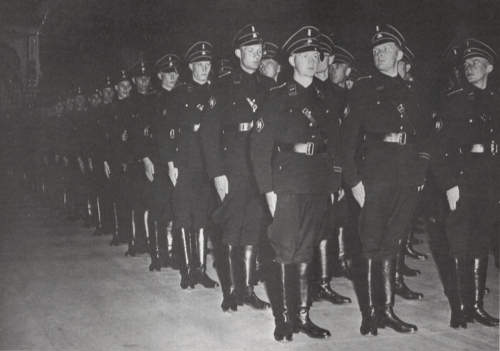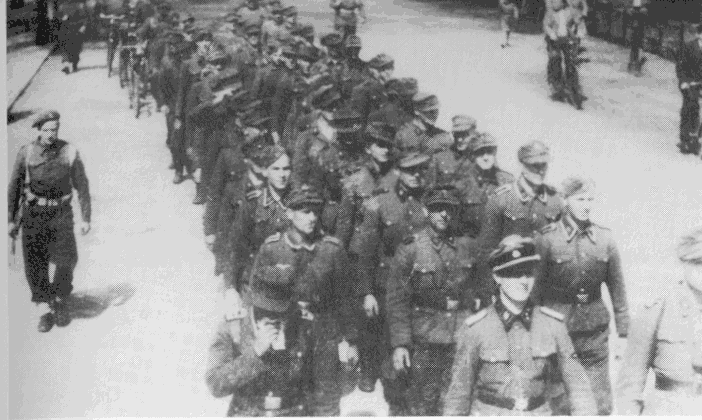
It is easy to say that all Germans in the Third Reich were bad , but that would be a great mistake to make. The majority weren’t bad, and many were victims like so many others. Yes, many had become complacent and were seduced by the promises made by Hitler, However, not everyone subscribed to the ideology of the Nazis. Some even highly placed officials, saw what the Nazis were and tried to do something about it.
On March 22 mArthur Kahn together with Ernst Goldmann, Rudolf Benario, and Erwin Kahn(not related), were arrested , for being communist party members and were send to Dachau.

Upon arrival in Dachau, the men were identified as Jews and tortured. On April 11, 1933 a group of drunken SS officers handed the four young men shovels and made them march to the outskirts of the camp, where they were executed Arthur Kahn was the first one shot. Making him the first Holocaust victim.
Josef Michael Hartinger was a German lawyer who worked for the Bavarian State authorities in the latter years of the Weimar Republic when the Nazis came to power. Tasked with investigating some unnatural deaths at the Dachau concentration camp near Munich, Hartinger together with his medical examiner colleague, Moritz Flamm , discovered the SS policy of summary executions and faked suicides at the camp. At great risk to his own safety, Hartinger issued an indictment of the camp authorities, which was ultimately betrayed and suppressed.
Hartinger’s goal was to obtain a conviction for a chain-of-command order for the multiple murders that had occurred in the first weeks of the camp’s operation.
In 1933 Hilmar Wäckerle was picked by his old friend Himmler to be commandant of the newly established Dachau concentration camp. Under orders from Himmler, he established ‘special’ rules for dealing with prisoners, rules that instituted terror as a way of life at the camp.
Suspecting SS accounts immediately, Hartinger investigated the camp deaths as homicides, getting proof from autopsies by an equally courageous medical examiner, Dr. Moritz Flamm. Hartinger was a gifted and competent lawyer. He had also demonstrated courage in the First World War, and pugnacity in his legal prosecutions. Despite the danger to his person and the hesitation of his superiors, Hartinger showed both fastidious professionalism and moral courage in building his case against the murderers at Dachau.
On 11 April when an SS detachment took four Jewish prisoners out of the grounds and, after beating them badly, shot them in the back of the head. The murder victims were reported as “shot while trying to escape”.
Camp commandant Hilmar Wäckerle showed them to a spot where the four prisoners were shot while trying to escape into the woods and later to a shed where three of their bodies were piled on the floor. Hartinger berated the guards on the undignified treatment of the bodies before, he told them “That is not how you treat a human being” Hartinger and Dr. Flamm set about identifying and examining them. They quickly noted that all the dead prisoners were Jewish and had been shot at the base of the skull. Erwin Kahn survived the escape shooting but four days later died while under SS guard in hospital. Without challenging the guards on these points, the investigators returned over several days to carefully document the evidence, with Flamm performing autopsies on the four prisoners. Hartinger and Flamm noted many inconsistencies between the injuries on the corpses and the camp guards’ accounts of the deaths.
With each visit, they had more and more deaths to investigate, such as the case of Sebastian Nefzger, a camp guard, who had allegedly committed suicide] The autopsy showed his back severely bruised all over and evidence of internal bleeding. He had allegedly tried to hang himself with the straps of his own prosthetic leg and when that failed, he had inflicted cuts on his own wrists so deep that they penetrated the bone. The autopsy of the lawyer Alfred Strauss, who was also shot trying to escape, revealed that he died of a bullet in the neck after suffering serious physical attacks. His back was covered with lacerations and his buttocks bandaged to hide a deep cut.

By German law ,at the time, the SS had committed crimes, because they were not legally a police force or even military force yet. When Hartinger showed his findings to his boss, Karl Wintersberger, he refused to sign the documents to start the indictments.
Wintersberger, a chief prosecutor who a decade before had intrepidly and successfully tried Nazi thugs, now lost his nerve, giving Heinrich Himmler, the head of the SS, and Hitler the opportunity to intervene to protect their henchmen. This didn’t stop Hartinger though.
In June 1933, Hartinger reduced the scope of the dossier to the four clearest cases. Johann Kantschuster was accused of murdering Alfred Strauss. Karl Ehmann was accused of murdering Leonhard Hausmann. The murderer of Louis Schloss and Sebastian Nefzer could not be identified so charges were brought against Wäckerle, Nürnbergk and Mutzbauer for abetting the murder and obstructing investigation.Wintersberger signed it, after first notifying SS Reichsführer Heinrich Himmler as a courtesy.
The killings at Dachau suddenly stopped temporarily, Wäckerle was transferred to Stuttgart and replaced by Theodor Eicke. The indictment and related evidence reached the office of the Bavarian Justice Minister, Hans Frank, but was intercepted by Gauleiter Adolf Wagner and locked away in a desk only to be discovered by the US Army after the war.
In 1946 files of the missing indictment were discovered by the US Army in the Bavarian Justice Ministry and were used in evidence in the trials of senior Nazis at the Nürnberg tribunal of 1947. Flamm’s thoroughly gathered and documented evidence within Hartinger’s indictment ensured it achieved convictions of senior Nazis such as Oswald Pohl. Wintersberger’s complicit behaviour is documented in his own evidence to the Pohl Trial.

What makes this story particularly poignant is the fact that Arthur Kahn, a 21-year-old Jewish German medical student had enrolled in Edinburgh University in Scotland, he had returned to , Germany to pick up his student records at the University of Wurzburg. Instead of finishing his studies, he became the first victim of the Holocaust.
Another thing that struck me in 1933 British Newspapers were already reporting about the killings in Dachau, 6 years before the war started.
Last night I watched a documentary where the story of Josef Hartinger was mentioned, in it, historian Timothy W. Ryback said “It is said ‘if we had 1000 Oskar Schindlers ,the Holocaust would not have happened. I say if we had 100 Hartingers the Holocaust would not have happened” I tend to agree with him.
sources
https://www.commonwealmagazine.org/hitlers-first-victims
https://www.newspapers.com/article/the-wisconsin-jewish-chronicle-16-more-j/11869954


































You must be logged in to post a comment.